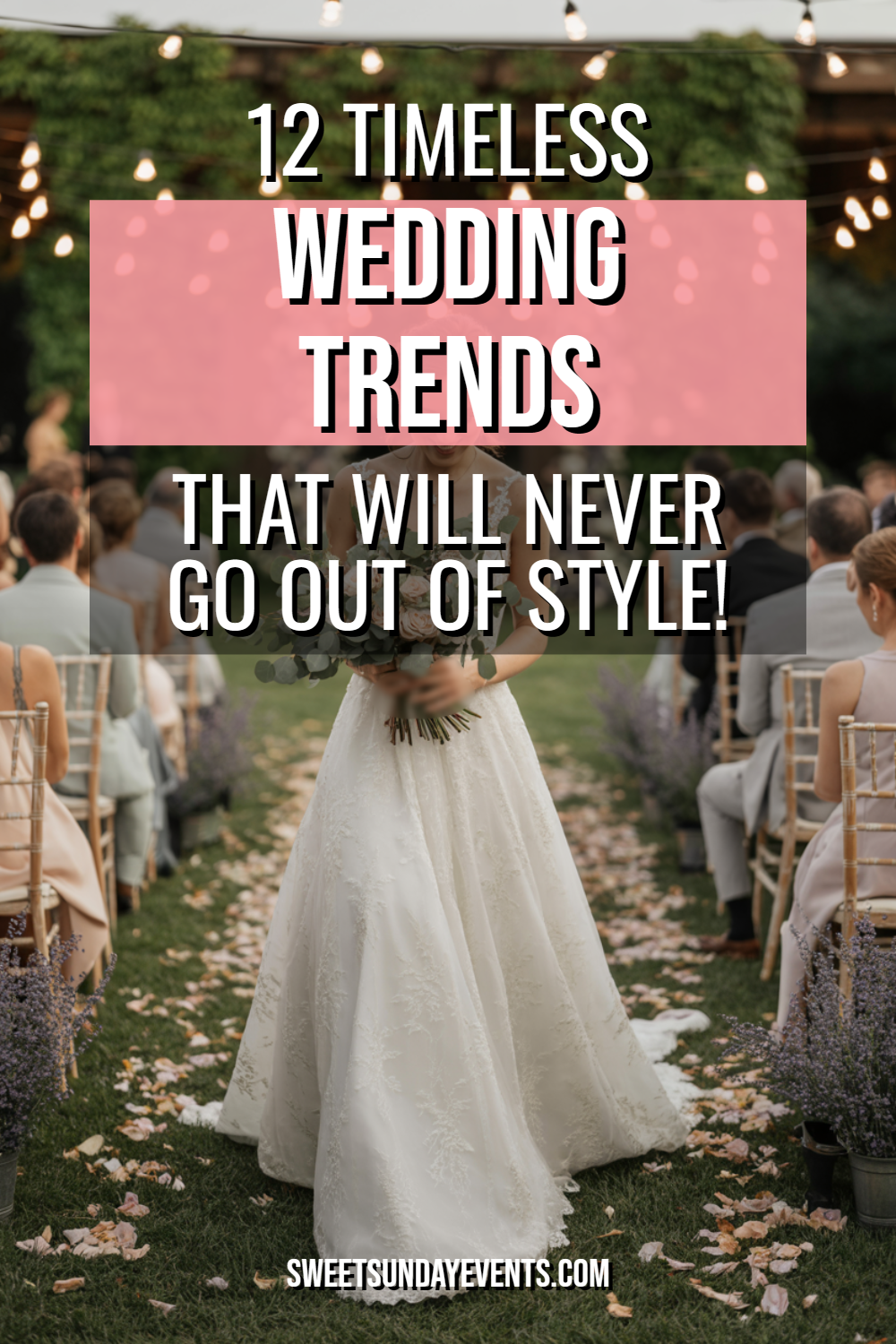Some wedding trends come and go faster than you can say “Pinterest board,” but others have staying power that transcends decades. These twelve elements have graced ceremonies for generations and continue to make couples swoon—and for good reason.
1. Classic White Wedding Dress
The white wedding dress isn’t going anywhere, despite what fashion magazines might tell you about “bold color statements.” There’s something undeniably magical about that pristine moment when a bride steps into her gown for the first time.
Sure, Queen Victoria started this trend back in 1840, but it stuck because white symbolizes new beginnings in a way that feels both personal and universal.
Every generation finds their own way to interpret it—whether through vintage lace, modern minimalism, or dramatic ball gowns.
2. Fresh Flower Arrangements
Real flowers will always trump artificial ones, no matter how convincing the fakes become.
The scent of fresh blooms, the way petals catch natural light, and yes, even the slight imperfections that make each arrangement unique—these details create an atmosphere that silk flowers simply can’t replicate.
Seasonal blooms also connect your wedding to the natural world in a way that feels authentic. Spring peonies, summer roses, autumn dahlias, or winter evergreens each bring their own personality to the celebration.
3. Exchanging Personal Vows
Cookie-cutter vows went out with the ’80s shoulder pads. Couples discovered that speaking from the heart creates moments that are genuinely moving, not just Instagram-worthy.
Personal vows transform the ceremony from a formal procedure into an intimate conversation that happens to have witnesses. They’re vulnerable, honest, and often sprinkled with inside jokes that make guests smile through their tears.
4. Live Music During the Ceremony
A string quartet, acoustic guitarist, or even a single violin adds emotional weight that recorded music can’t match. Live musicians respond to the energy in the room, slowing down for dramatic moments or building crescendos that give everyone chills.
The slight imperfections—a note that wavers with emotion, the way musicians watch the processional timing—these human touches make ceremonies feel more connected and less choreographed.
5. Candlelit Reception Ambiance
Candlelight is the ultimate beauty filter, and not just for photos. It creates an intimate atmosphere that makes everyone look radiant and feel like they’re part of something special rather than attending a corporate event.
Whether it’s simple votives scattered across tables or elaborate candelabras as centerpieces, flickering flames add warmth that overhead lighting can’t achieve. Plus, candles photograph beautifully without looking dated years later.
6. Dancing as the Main Entertainment
DJ or band, first dance or party playlist—dancing remains the heart of wedding receptions because it’s pure joy in motion. Watching your grandmother bust a move to your favorite song creates memories that no amount of elaborate entertainment can top.
The dance floor is where generations mingle, where shy cousins become party legends, and where the real celebration happens. It’s democratic, inclusive, and absolutely timeless.
7. Traditional Wedding Cake Cutting
Despite the rise of dessert bars and donut walls, the wedding cake cutting ceremony endures because it’s steeped in symbolism.
The first task completed together as a married couple, the sharing of sweetness, the playful (or not-so-playful) feeding of each other—these moments resonate across cultures.
Even couples who serve alternative desserts often keep a small cutting cake for this ritual. There’s something about that knife in four hands that signals the real beginning of married life.
8. Formal Wedding Photography
Smartphone cameras have improved dramatically, but professional wedding photography remains irreplaceable.
Skilled photographers capture not just posed portraits but the fleeting moments—a father’s proud smile, a flower girl’s concentration, the way light falls across a couple’s joined hands.
Professional photographers also understand wedding day timing and can work around family dynamics (trust me, every family has that one uncle). They’re investment pieces that pay dividends for decades.
9. Wedding Favors with Meaning
Cheap trinkets are finally dying out, but meaningful wedding favors continue to delight guests. Edible treats, charitable donations made in guests’ honor, or small items that reflect the couple’s story create connections rather than clutter.
The best favors feel like genuine thank-you gifts rather than obligatory table decorations. When guests actually use or cherish them months later, you know you’ve chosen well.
10. Bridal Party Traditions
Bridesmaids and groomsmen serve practical and emotional purposes that transcend trends. They’re your support system, your photo props, and your built-in party starters all rolled into one.
The tradition evolved from ancient beliefs about confusing evil spirits, but today’s bridal parties are about surrounding yourself with your favorite people during one of life’s biggest moments. The matching outfits are just a bonus.
11. Something Old, Something New
This Victorian-era tradition persists because it acknowledges both continuity and change—perfect metaphors for marriage itself.
Grandmother’s pearls, a new dress, borrowed shoes, and a blue garter create layers of meaning that feel both personal and connected to history.
Modern couples often put creative spins on these elements, but the underlying concept of honoring the past while embracing the future remains powerful.
12. Romantic First Dance
The first dance as a married couple creates a bubble of intimacy in the middle of a party. Whether you choose a meaningful song, take lessons for months, or just sway together naturally, this moment belongs entirely to you two.
Even couples who “don’t dance” often find themselves moved by the tradition. There’s something about being surrounded by everyone you love while focusing entirely on each other that makes the rest of the world fade away.
Why These Trends Endure
These elements survive fashion cycles because they serve emotional rather than aesthetic purposes. They create moments, foster connections, and honor the significance of marriage itself.
Trends that focus purely on visual impact tend to look dated quickly, but traditions rooted in human emotion remain relevant across generations. They’re the backbone that supports all the pretty details you’ll add to make your wedding uniquely yours.


